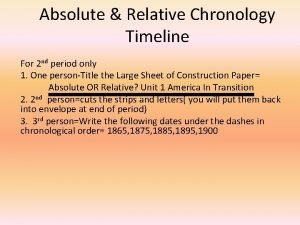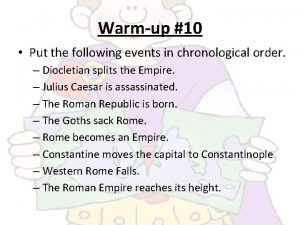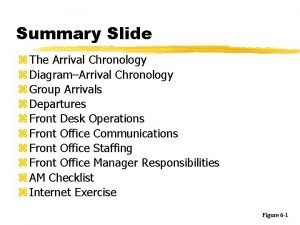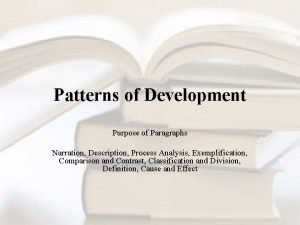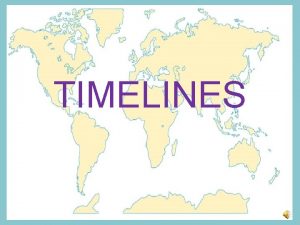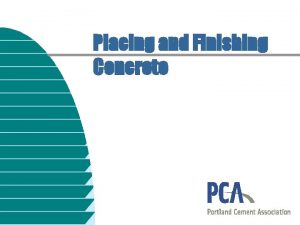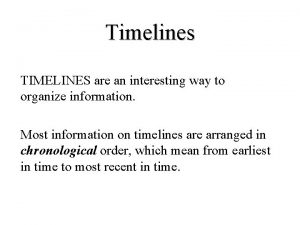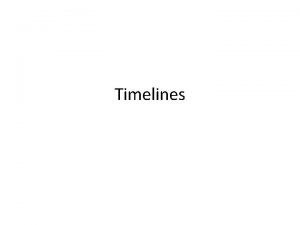Chronology and Timelines Chronology Placing events in chronological













- Slides: 13

Chronology and Timelines

Chronology • Placing events in chronological order means putting them in the order in which they happened. ▫ Using this system, an event that happened in 1802 would come before an event that happened in 1902.

Chronological Order • There a few ways to organize events in chronological order. ▫ One way is to make a list of events, with the events that happened first appearing at the top of the list. • For example, the list below is in chronological order: ▫ Arrival of the Pilgrims on the Mayflower ▫ Signing of the Declaration of Independence ▫ The War of 1812 ▫ The Battle of Gettysburg ▫ Assassination of President Abraham Lincoln ▫ World War I ▫ The Great Depression ▫ Japanese attack on Pearl Harbor ▫ First walk on the moon by astronaut Neil Armstrong ▫ Space Shuttle Challenger accident ▫ Desert Storm (The Persian Gulf War)

Timelines • One common way of putting events in chronological order is by creating a timeline. • Timelines are read from left to right or from top to bottom and are marked by years, decades, or centuries. • Two or more timelines put together to compare different events in the same era is called a "multi-tier timeline. "

Timelines • The timeline below is an example of a multi-tier timeline comparing events from the 1600 s.

Measuring Time & Time Concepts • There are different ways that time is measured. ▫ Time can be measured by minutes, hours, days, years, decades, and centuries. �Year — There are 365 days in one year. �This is the amount of time it takes the Earth to orbit the sun. �Decade — There are 10 years in a decade. �For example, the 1990 s represent one decade, or the years of 1990 to 1999. �Century — There are 100 years in a century. �For example, the years 1901 to 2000 are one century, called "the twentieth century. "

Measuring Time & Time Concepts �Millennium — There are 1, 000 years in a millennium. �For example, the years 1001 to 2000. �Era — An era is a period of time marked by a special event or leader. �An era is not a set number of years. �Examples include the Victorian Era (marked by Queen Victoria's rule over Great Britain) and the Civil War Era (the time of the American Civil War during the 1860 s). �Another word for "era" is "age" or "period. "

Understanding B. C. and A. D. • B. C. or B. C. E. ▫ ▫ B. C. means "Before Christ" B. C. E. means "Before the Common Era. " These are the years before 1 A. D. It is important to remember that the year 500 B. C. and 500 B. C. E. mean the same thing. ▫ It is also important to know that, for the years prior to 1 A. D. , we count backwards. �This means that 400 B. C. occurred before 200 B. C.

Understanding B. C. and A. D. • A. D. or C. E. • A. D. means "Anno Domini" (in the year of our Lord) • C. E. means the "Common Era. " • Having a year marked as either A. D. or C. E. refers to years starting with 1 A. D. to the present-day. • For the A. D. or C. E. years, we count forward. • This means that 1997 occurred after 1392.

Dates on a Timeline • B. C. and B. C. E. dates go from higher numbers (500 B. C. or B. C. E. ) to lower numbers (200 B. C. or B. C. E. ). • A. D. and C. E. dates go from lower numbers (100 A. D. or C. E. ) to higher numbers (2001 A. D. or C. E. ) 500 BC 375 BC 250 BC 125 BC B. C. or B. C. E 508 AD 0 (#’s decrease as time passes) 1008 AD 1508 AD 2008 AD A. D. or C. E. (#’s increase as time passes) Birth of Jesus

Interpreting a Timeline • Which year is closer to the present or today? ▫ 25 B. C. , 2000 B. C. , 500 B. C. E. , 125 B. C. E. ▫ 2012 B. C. E. , 2000 C. E. , 1500 B. C. E. , 2010 C. E. • How many years are between the dates below? ▫ 375 B. C. and 125 B. C. ▫ 125 B. C. and 500 A. D. ▫ 250 B. C. E. and 1500 C. E.

Interpreting Multiple-Tier Timelines • What is the title of the timeline? • How many years are covered in B. C. ? A. D. ? • How many years TOTAL does the timeline cover?

Why do we use BCE/CE and BC/AD? • Although Christians make up a large part of the world’s population, they are less than a majority. *As a result, B. C. E. is often used by those who wish to avoid a reference to Christianity. • The date A. D. 1 was first used when Jesus was born. * However, later it became evident that Jesus was not actually born that year, but a few years earlier. • Because of a variety of changes and adjustments that were made to the calendar during the Middle Ages, it appears that Jesus was probably born in 6 B. C. and most likely lived until 30 A. D. * Using C. E. , or Common Era, allows the same historic period to be used even though the estimate for when Jesus was born has changed.
 Present simple timeline
Present simple timeline Sprint timelines
Sprint timelines What century are we in
What century are we in Chronological timeline
Chronological timeline Absolute chronology is used to describe events
Absolute chronology is used to describe events B.c to a.d timeline
B.c to a.d timeline Put the following events in chronological order history
Put the following events in chronological order history Mutually exclusive vs non mutually exclusive
Mutually exclusive vs non mutually exclusive Placing and finishing concrete
Placing and finishing concrete Chronology of activities
Chronology of activities What steps in the arrival chronology could be shortened
What steps in the arrival chronology could be shortened Chronologies in social work
Chronologies in social work Paragraph patterns of development
Paragraph patterns of development Chronology of pauline epistles
Chronology of pauline epistles




